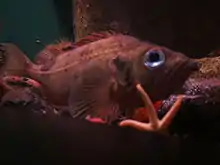ǫgr
See also: ogr
Old Norse
Etymology 1

ǫgr
Ultimately from Proto-Indo-European *h₂eḱ- (“sharp”), named so after the numerous spikes on its head, compare Swedish abborre (“perch”). The alternative forms are due to a folk etymological connection to auga (“eye”), because of its large protruding eyes, compare Russian окунь (okunʹ, “perch”), from Russian око (oko, “eye”).[1]
Alternative forms
- augr, augurr
Etymology 2
Uncertain. Perhaps related to Latin ocris (“ragged mountain”), Ancient Greek ὄκρις (ókris, “peak”), in that case from Proto-Indo-European *h₂óḱris. Alternatively related to Latin acer (“sharp”), Ancient Greek ᾰ̓́κρος (ákros, “pointed, sharp”), in that case from Proto-Indo-European *h₂ḱrós.[1] Both ultimately from Proto-Indo-European *h₂eḱ- (“sharp”).
Declension
References
- de Vries, Jan (2000) Altnordisches etymologisches Wörterbuch [Old Norse Etymological Dictionary] (in German), 2nd revised edition, Leiden: Brill, p. 374
- ögr in A Concise Dictionary of Old Icelandic, G. T. Zoëga, Clarendon Press, 1910, at Internet Archive.
This article is issued from Wiktionary. The text is licensed under Creative Commons - Attribution - Sharealike. Additional terms may apply for the media files.